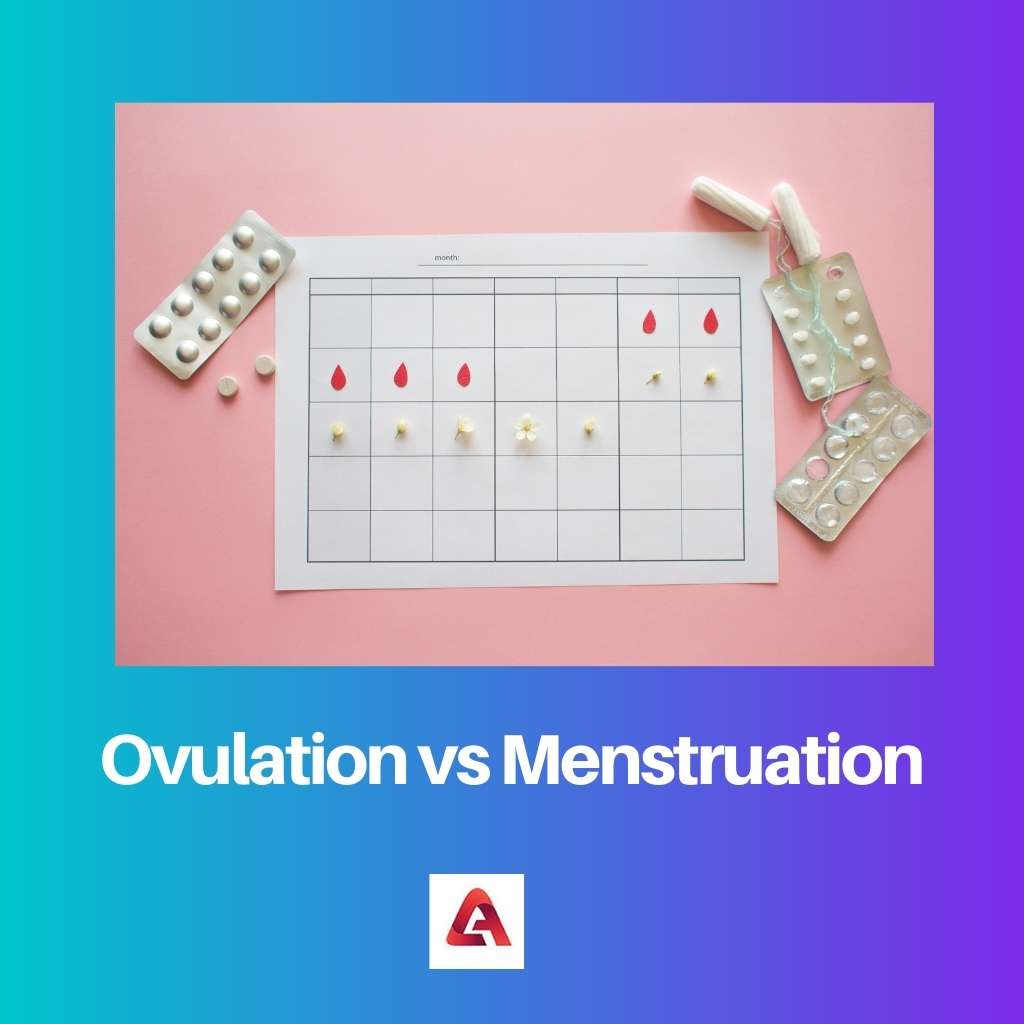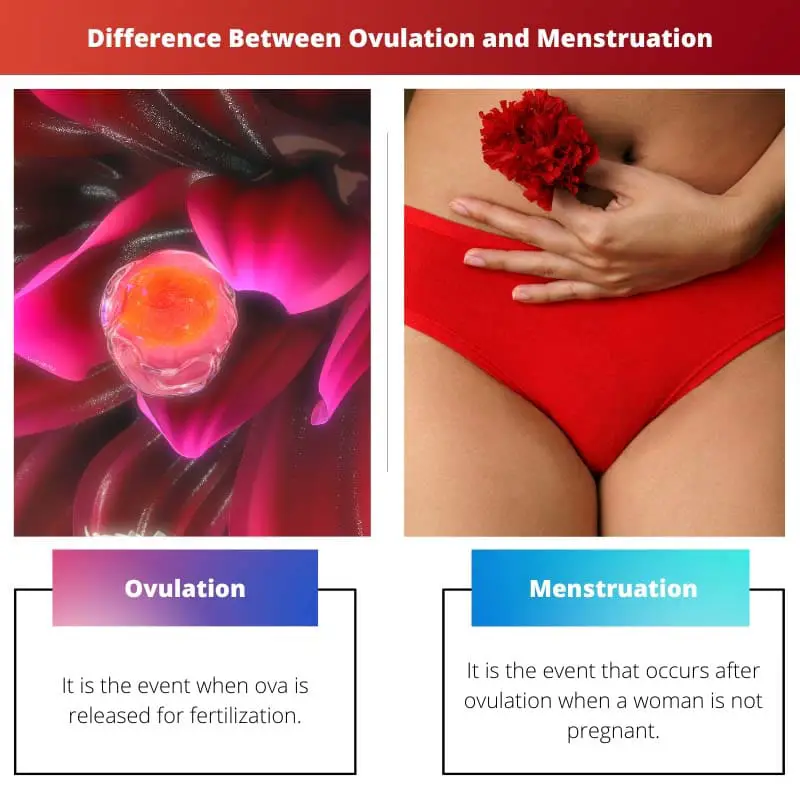The human body is extremely complicated, with several functions and activities, Getting menses is one of these stages. Every month, every young woman gets her period.
The menstrual cycle is defined as having monthly periods. This procedure is critical for the survival of the human species in a woman’s body.
Key Takeaways
- Ovulation is the release of a mature egg from the ovary, while menstruation is the shedding of the uterine lining.
- Ovulation occurs midway through the menstrual cycle, whereas menstruation marks the beginning of a new cycle.
- Ovulation is a crucial part of the reproductive process, while menstruation is the body’s way of preparing for a potential pregnancy.
Ovulation vs Menstruation
Ovulation is a physiological process in females wherein a mature egg is released from the ovary, taking place around the midpoint of the menstrual cycle. Menstruation is a cyclic phenomenon in which the lining of the uterus is shed when a fertilized egg does not implant itself.

The release of mature eggs from the ovaries is the process of ovulation in women. When ovarian follicles rupture, the mature egg is released in the form of secondary oocyte ovarian cells.
Following the release of the egg, it is available for fertilisation by sperm. The uterus undergoes a number of modifications that make it easier to conceive a child.
In colloquial slang, menstruation is referred to as “periods.” It is monthly blood and mucosal tissue discharge.
The inner lining of the uterus has broken down, resulting in bleeding. The bleeding that occurs is caused by the rise and decrease of hormone levels in the body.
Comparison Table
| Parameters of Comparison | Ovulation | Menstruation |
|---|---|---|
| Meaning | It is the event when ova is released for fertilization. | It is the event that occurs after ovulation when a woman is not pregnant. |
| Occurrence | It occurs after every 14th day of the menstrual cycle. | It lasts ideally for 28 days, and the woman starts menstruating on the first day of the cycle. |
| Temperature changes in the body | The temperature increases during ovulation | The temperature decreases during menstruation. |
| Hormonal level | Estrogen, LH, FSH is high | Progesterone, estrogen, LH, FSH is low |
| Site of action | The ovary releases secondary oocytes. | The uterine lining is the endometrium wall, that sheds during menstruation. |
What is Ovulation?
Ovulation occurs in the middle of the menstrual cycle when eggs (ova) are released for fertilisation. After the follicular phase, the ovulation process begins.
These are the days when a woman’s uterus is at its most fertile and conducive to conception. The egg is ready for fusion with the sperm at this point.
Fertilization is the process of sperm and eggs joining together.
The length of a typical menstrual cycle and the date of the previous menstrual period are used to calculate the days when a woman is most fertile.
The most productive phase of the 28-day cycle lasts around 10 to 18 days.
The computation begins with the last (LMP), known as the last menstrual cycle, and continues for an average of 14.6 days until ovulation.
Depending on a variety of factors, these calculated days may differ from woman to woman.
The oestrogen hormone reaches its peak about 12 to 24 hours after the follicular phase ends. The surge of hormones such as (LH) luteinizing hormone and (FSH) follicle-stimulating hormone is caused by positive feedback.
The release of the oocyte from the ovary is caused by a surge in hormones that lasts about 24 to 36 hours and is caused by the rupture of the ovarian follicle.
What is Menstruation?
Periods are another name for menstruation. It is the monthly bleeding that every woman experiences.
Menarche is the first episode of bleeding that occurs, and it normally occurs between the ages of 12 and 15 years. It is not unusual for a girl to get her first period at the age of eight, as this is related to changes in lifestyle and time.
In young female women, the duration between the start day of one period and the first day of the following period is between 21 to 45 days.
These days are not accurate; they can range from 21 to 31 days depending on the lady, with the average or most typical period being about 28 days.
The inner lining of the uterus, which is made up of blood tissues, breaks down, causing bleeding. The endometrium wall, or inner lining, is made up of endometrial tissue.
Every month, a new wall is built to give support for the baby following the fusion. Menstruation lasts 5 to 7 days, depending on the thickness of the endometrial wall.
Menopause occurs when a woman’s period stops, indicating that she is no longer capable of bearing children. It strikes women between the ages of 45 and 50.

Main Differences Between Ovulation and Menstruation
- Ovulation is the release of ova from the ovary, whereas menstruation is the shedding of ova (egg) and blood tissues.
- During ovulation, a woman is most fertile and can only conceive at this time. Nevertheless, during menstruation, a woman cannot conceive because she got her periods, which means she is not pregnant.
- There is an increase in estrogen levels during the follicular phase, which causes the release of LH, which starts the ovulation process. Menstruation, on the other hand, is caused by a drop in progesterone levels, indicating that pregnancy has not occurred.
- During ovulation, women may have a tiny amount of egg white discharge, whereas during menstruation, women may experience a large amount of red blood discharge.
- If a woman’s menstrual cycle is 28 days, she ovulates on the 14th day, whereas menstruation lasts roughly 5 to 7 days.

- https://academic.oup.com/jcem/article-abstract/87/1/63/2846605
- https://www.hindawi.com/journals/bmri/2015/751571/
- https://journals.plos.org/plosone/article?id=10.1371/journal.pone.0258314